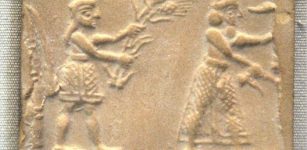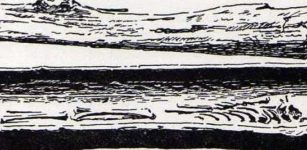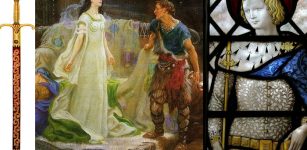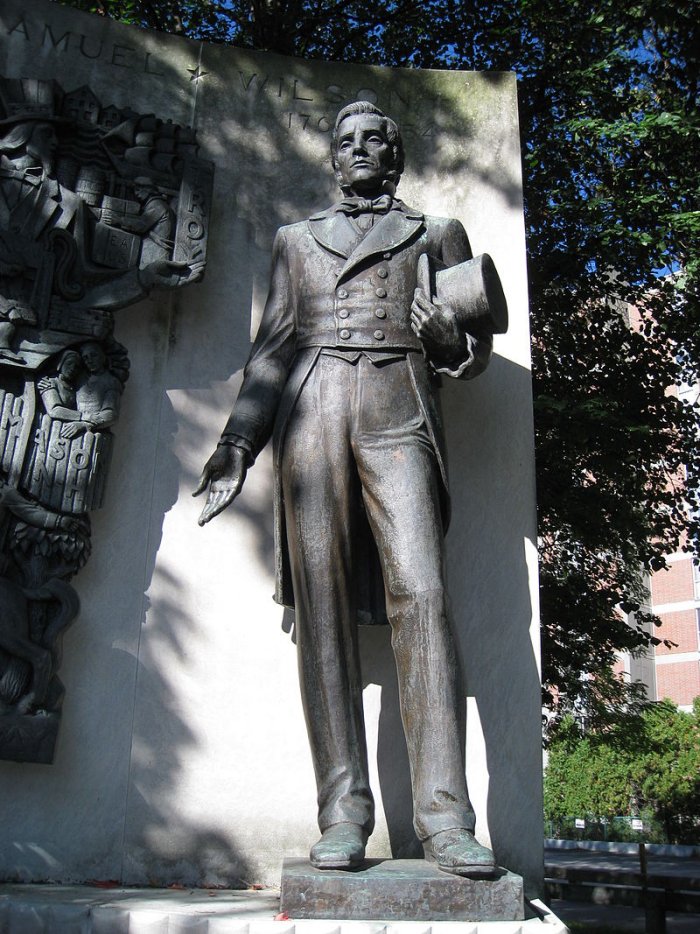Story Of Uncle Sam – Symbol Of The United States Government
Ellen Lloyd - AncientPages.com - You've seen him, alright. A slightly funny-looking man dresses in red, white, and blue. He wears a stars-and-stripes suit top hat and looks straight at you. His name is Uncle Sam, and he is a symbol of the United States government.
Samuel Wilson Memorial in Arlington, Massachusetts. Image credit: Wikipedia
How did this man become a personification of the American government, and how did the United States get its nickname, Uncle Sam?
Who Was Sam Wilson?
The story of Uncle Sam has its start in the 1810s. There was a real-life Uncle Sam, but proof of his existence was unearthed only a quarter of a century ago. Had the evidence not surfaced, doubt about a real-life prototype would still exist, and the character would today be considered a myth, as he was for decades.
The name Uncle Sam is linked to Samuel Wilson, born in Arlington, Massachusetts, on September 13, 1766.
When Sam was 14, he joined the army and the American Revolution. With independence from Britain won Sam moved in 1789 to Troy, New York, where he worked as a meatpacker and supplied barrels of beef to the United States Army during the War of 1812.
Wilson stamped the barrels with "U.S." for the United States, but soldiers began referring to the grub as "Uncle Sam's."
On October 1, 1812, Sam was visited by government inspectors who asked him what the ubiquitously stamped "U.S." stood for. Sam was a little uncertain and joked that the letters must represent the initials of his employer, Uncle Sam.
The local newspaper picked up on the story, and Uncle Sam eventually gained widespread acceptance as the nickname for the U.S. federal government.
Samuel Wilson died in 1854 and was buried next to his wife Betsey Mann in the Oakwood Cemetery in Troy, New York, the town that calls itself "The Home of Uncle Sam."
Uncle Sam Becomes A Symbol Of The United States Government
Over the years, various artists depicted Uncle Sam in different ways. The colorful image of Uncle Sam we are familiar with today is a creation made up of several contributions by many illustrators.
The first Uncle Sam illustrations appeared in New England newspapers in 1820. At that time, the friendly figure was clean-shaven and wore a solid black top hat and tailcoat.
Uncle Sam, a half-length portrait, pointing at the viewer as part of the United States government's effort to recruit soldiers during World War I, with the famous legend "I want you for the U.S. Army". Image credit: Library Of Congress
In the late 1860s and 1870s, political cartoonist Thomas Nast (1840-1902) began popularizing the image of Uncle Sam. Nast gave Uncle Sam the white beard and stars-and-stripes suit associated with the character today.
The famous image of Uncle Sam wearing a tall top hat and blue jacket and pointing straight ahead at the viewer was created by artist James Montgomery Flagg (1877-1960).
During World War I, this portrait of Sam with the words "I Want You For The U.S. Army" was used as a recruiting poster.
In September 1961, the U.S. Congress recognized Samuel Wilson as "the progenitor of America's national symbol of Uncle Sam. In 1989, "Uncle Sam Day" became official.
Updated on August 15, 2023
Written by Ellen Lloyd – AncientPages.com
Copyright © AncientPages.com All rights reserved. This material may not be published, broadcast, rewritten or redistributed in whole or part without the express written permission of AncientPages.com
Expand for referencesMore From Ancient Pages
-
 Yasuke – The First Black Samurai Caused A Sensation In Japan
Featured Stories | Oct 25, 2019
Yasuke – The First Black Samurai Caused A Sensation In Japan
Featured Stories | Oct 25, 2019 -
 Medieval Bollock Dagger – Also Known As Kidney Dagger Discovered In Belgium
Archaeology | Mar 30, 2022
Medieval Bollock Dagger – Also Known As Kidney Dagger Discovered In Belgium
Archaeology | Mar 30, 2022 -
 On This Day In History: First Battle Of Gaza Was Fought – On March 26, 1917
News | Mar 26, 2017
On This Day In History: First Battle Of Gaza Was Fought – On March 26, 1917
News | Mar 26, 2017 -
 Who Was The Sumerian Ensi?
Featured Stories | Jan 24, 2020
Who Was The Sumerian Ensi?
Featured Stories | Jan 24, 2020 -
 Katanga Cross: Symbol Of Secrets, Power And Valuable Currency Of The Congolese People
Ancient Symbols | Sep 10, 2018
Katanga Cross: Symbol Of Secrets, Power And Valuable Currency Of The Congolese People
Ancient Symbols | Sep 10, 2018 -
 Underground Civilizations – True Rulers Of Earth – Part 1
Ancient Mysteries | May 7, 2019
Underground Civilizations – True Rulers Of Earth – Part 1
Ancient Mysteries | May 7, 2019 -
 Ancient Scents Can Be Reconstructed With Help Of Modern Science – Researchers Say
Archaeology | Mar 28, 2022
Ancient Scents Can Be Reconstructed With Help Of Modern Science – Researchers Say
Archaeology | Mar 28, 2022 -
 Shining Ones, Archimedes Death Ray And Mystery Of Vitrified Forts In Scotland
Ancient Technology | May 13, 2015
Shining Ones, Archimedes Death Ray And Mystery Of Vitrified Forts In Scotland
Ancient Technology | May 13, 2015 -
 Why Do Old Norse Myths Endure In Popular Culture?
Featured Stories | Mar 16, 2023
Why Do Old Norse Myths Endure In Popular Culture?
Featured Stories | Mar 16, 2023 -
 More Than 60,000 Ancient Maya Structures Obscured By Inaccessible Forest Revealed By LIDAR
Archaeology | Sep 29, 2018
More Than 60,000 Ancient Maya Structures Obscured By Inaccessible Forest Revealed By LIDAR
Archaeology | Sep 29, 2018 -
 Humans In Africa Fled To The Mountains During The Last Ice Age
Archaeology | Aug 9, 2019
Humans In Africa Fled To The Mountains During The Last Ice Age
Archaeology | Aug 9, 2019 -
 Ancient Burial Of A Princess Who Fell Off A Cliff Raises Many Questions
Archaeology | Apr 18, 2019
Ancient Burial Of A Princess Who Fell Off A Cliff Raises Many Questions
Archaeology | Apr 18, 2019 -
 Gengen Wer – Goose God Who Guarded The Celestial Egg Containing The Life Force In Egyptian Beliefs
Featured Stories | Apr 22, 2021
Gengen Wer – Goose God Who Guarded The Celestial Egg Containing The Life Force In Egyptian Beliefs
Featured Stories | Apr 22, 2021 -
 Famous Bayeux Tapestry May Solve The Planet Nine Mystery
Archaeoastronomy | May 5, 2018
Famous Bayeux Tapestry May Solve The Planet Nine Mystery
Archaeoastronomy | May 5, 2018 -
 Curtana – Sword Of Mercy Once Belonged To The Anglo-Saxon King Edward The Confessor And Perhaps Even The Arthurian Hero Tristan
Artifacts | Jul 16, 2017
Curtana – Sword Of Mercy Once Belonged To The Anglo-Saxon King Edward The Confessor And Perhaps Even The Arthurian Hero Tristan
Artifacts | Jul 16, 2017 -
 Ancient Societies Ruled By Ruthless Dictators – Collapsed
Civilizations | Oct 18, 2020
Ancient Societies Ruled By Ruthless Dictators – Collapsed
Civilizations | Oct 18, 2020 -
 Shieldmaiden Hervör’s Dangerous Quest For The Cursed Tyrfing Sword
Featured Stories | Apr 20, 2023
Shieldmaiden Hervör’s Dangerous Quest For The Cursed Tyrfing Sword
Featured Stories | Apr 20, 2023 -
 Rare Bes Mugs Reveal Ancient Egyptians Drank Hallucinogenic Cocktails During Rituals
Archaeology | Nov 18, 2024
Rare Bes Mugs Reveal Ancient Egyptians Drank Hallucinogenic Cocktails During Rituals
Archaeology | Nov 18, 2024 -
 On This Day In History: American General Benedict Arnold Commits Treason – On Sep 21, 1780
News | Sep 21, 2016
On This Day In History: American General Benedict Arnold Commits Treason – On Sep 21, 1780
News | Sep 21, 2016 -
 Moses’ Secret Knowledge Of Superior And Forbidden Technology – Alien Intervention And Events Erased From Historical Records – Part 2
Ancient Mysteries | Sep 24, 2020
Moses’ Secret Knowledge Of Superior And Forbidden Technology – Alien Intervention And Events Erased From Historical Records – Part 2
Ancient Mysteries | Sep 24, 2020


